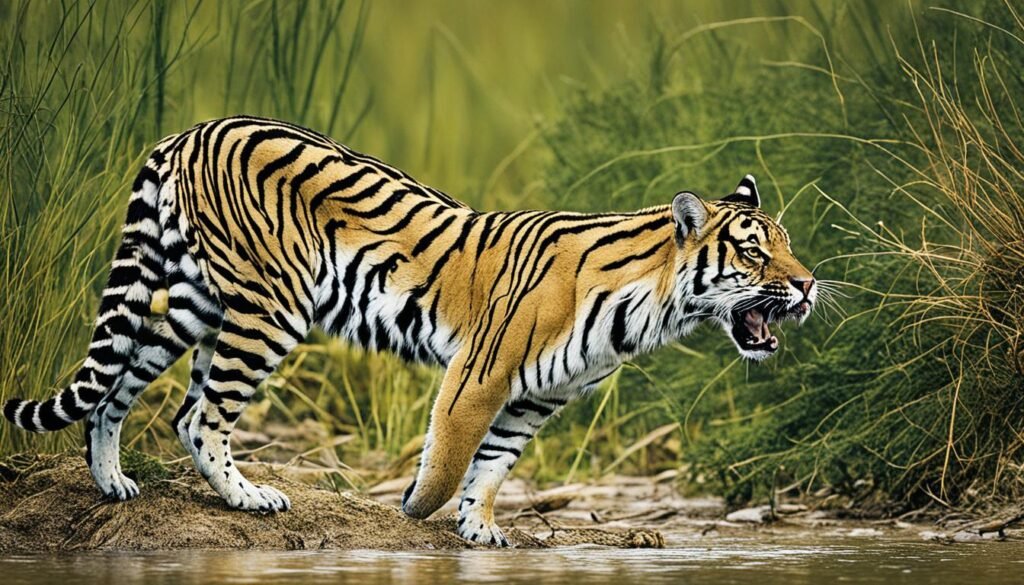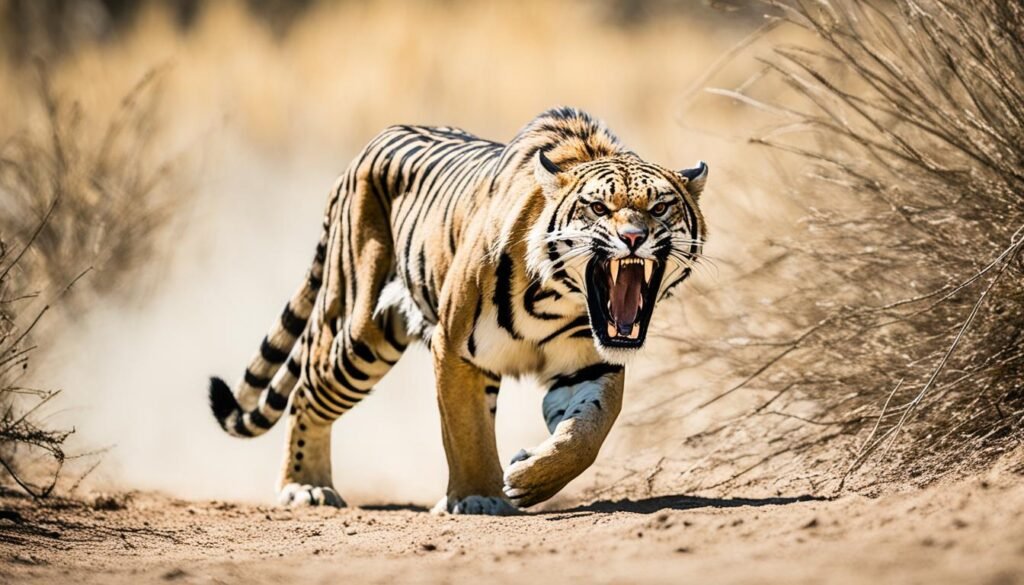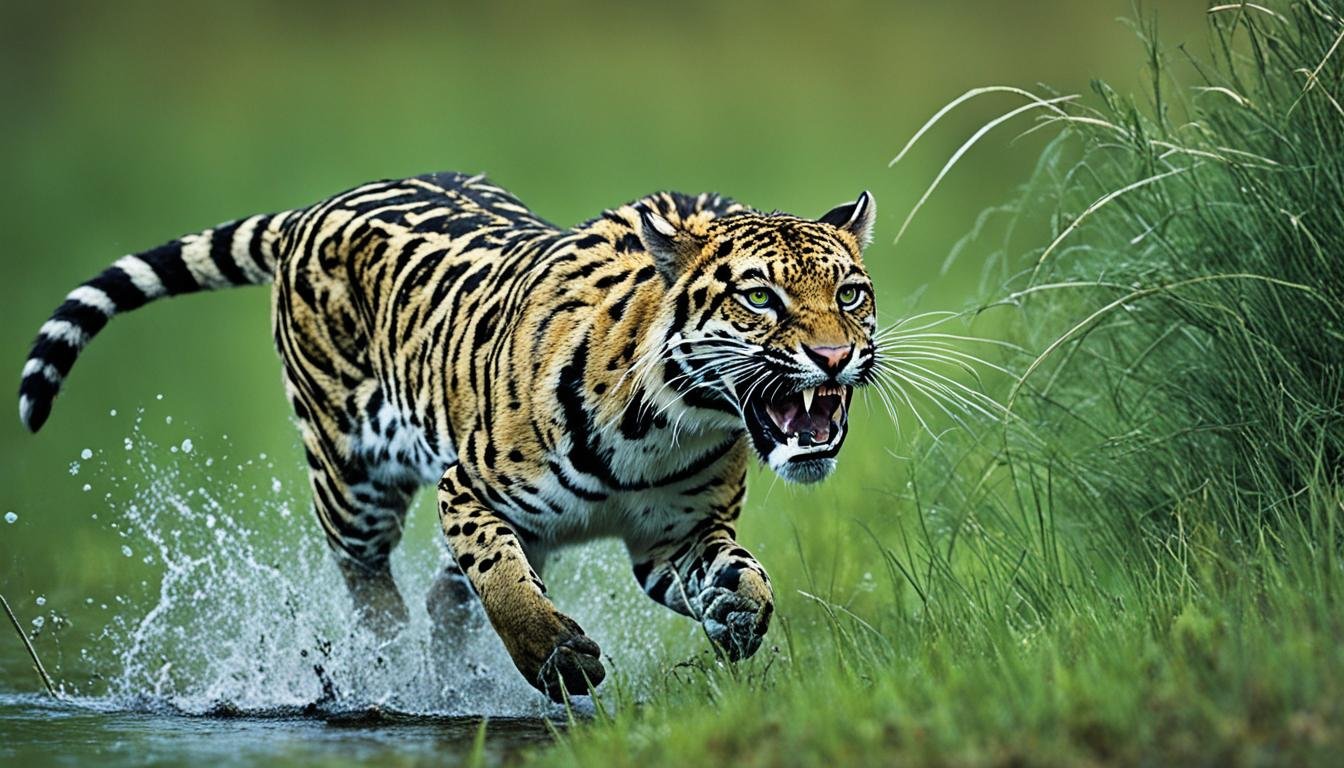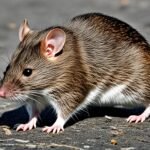Predatory animals and apex predators are crucial in our planet’s ecosystems. They stand at the top of the food chain, keeping nature in balance. For example, the African lion, a major land predator, and the saltwater crocodile, the biggest living reptile, are key players in their environments.
Apex species like the great skua and the gray wolf show the variety of predatory ways. While crocodiles rule the waters, wolves have changed Yellowstone since they came back. Each apex predator impacts their world, proving their importance in the food chain. But what about when humans and climate change threaten these apex predators? Let’s find out more about these essential creatures and their challenges.
The Critical Role of Predatory Animals in Ecosystems
Predators and prey interactions are key to healthy ecosystems. They help control biodiversity, ensuring every animal plays its part. Predation goes beyond just hunting. It balances the food chain and keeps nature thriving.
Trophic Relationships and the Dynamics of Food Webs
Predators play a central role in ecosystems. Wolves, bears, and mountain lions are at the top of the food chain. They impact more than just their prey. They maintain biodiversity across the board. The lack of top predators can increase smaller predators. This affects the whole ecosystem in various ways.
Research shows the effects large predators have on their surroundings. For instance, fewer mountain lions in Zion National Park means less cottonwood trees. This impacts stream erosion and the wellbeing of different species. Even lesser-known animals like otters and badgers are important. They control prey numbers and help with the environment.
Impact of Predation on Biodiversity and Species Interactions
When big predators like bears decline, the ecosystem suffers. These animals provide many services, from controlling insects to enriching soil. Their decline, often from hunting and losing their homes, affects biodiversity. Look at Yellowstone Park. Bringing wolves back helped decrease elk numbers. This let plants and other animals flourish again. It shows how vital these predator-prey relationships are.
| Ecosystem Service | Large Predator | Impact on Biodiversity |
|---|---|---|
| Prey Population Regulation | Mountain Lions, Wolves | Preserves plant communities, reduces mesopredator populations |
| Nutrient Distribution | River Otters | Increases nitrogen content and growth of plant species |
| Habitat Aeration | Badgers | Contributes to soil fertility and underground species proliferation |
| Insect Control & Soil Enrichment | Bears | Facilitates forest health and growth |
| Species Diversity Maintenance | Coyotes, Birds of Prey | Regulates populations of birds, rodents, and other prey animals |
Predators, whether mammals, birds, reptiles, or sharks, shape ecosystems. Their loss warns us of our planet’s fragile health. Now, protecting these creatures is crucial for life’s balance. We’re moving towards caring for them through tagging, relocating, and educating. This shows we know their importance in nature.
Predator-Prey Interactions and Their Evolutionary Influence

The dance between apex predators and their prey fascinates ecologists. It shows a battle of brains, strength, and survival through evolution. Predator and prey improve their hunting tactics and survival strategies over time. This process demonstrates co-evolution’s impact on them and their ecosystems.
Adaptations for Hunting Success and Prey Survival Strategies
Carnivorous animals use ambush tactics for effective hunting. This surprise attack is common across many species. Prey animals, on the other hand, have developed things like camouflage to avoid these attacks. They’ve also made behavioral changes to increase their survival chances.
Some pack animals coordinate attacks through advanced communication. This helps them hunt better. In contrast, prey often work together or send warnings to avoid predators.
Co-evolution of Predator and Prey Species
The push and pull between power and vulnerability fuel co-evolution. Predators sharpen their senses to catch prey. At the same time, prey get better at detecting danger. This standoff pushes both to their evolutionary limits.
Ambush predators influence how their prey act and even their bodies. Reef fish, for example, hide in complex corals to stay safe. This shows how predators can change prey behavior and body shape.
The following table shows how predators and prey shape the ecosystem:
| Factor | Influence on Predator | Influence on Prey |
|---|---|---|
| Flow Velocity | Crabs exhibit highest predation rates at intermediate levels. | Hard clams reduce feeding time, making them less detectable. |
| Functional Traits | Spiders with individual traits dictate their niche and role in ecosystems. | Morphology predicts vulnerability in reef fish communities. |
| Sensory Capabilities | Predators with better sensing more likely to catch prey. | Prey with improved sensing can avoid predators more effectively. |
| Environmental Conditions | Knobbed whelks are more efficient in turbulent flows. | In rapid flows, foraging success of fish and other creatures is affected. |
This endless cycle showcases a dynamic display of adaptability and the will to live. It highlights the richness of our planet’s biodiversity and its constant evolution.
Characteristics Defining Apex Predators
Apex predators are at the top of the food chain. They are known for their size, strength, and hunting prowess. They have no natural foes and are key in keeping prey numbers in check and limiting smaller predators. These predators handle the food supply and help control population within ecosystems. Their special traits ensure a balance in nature, which is vital for all living things.
Traits of Dominance: Size, Strength, and Hunting Skills
Apex predators make a big impact on their homes. Take the Siberian tiger, for example. It lives in Russia’s far east, controlling a large area. It hunts deer and boar. Its hunting skills do more than just keep it alive. They keep the environment rich and varied.
Influence on Controlling Prey Density and Restricting Smaller Predators
Being at the top, apex predators naturally keep the number of smaller predators down. This is done directly and indirectly. For instance, the Iberian lynx reduces the numbers of mesocarnivores. This has a big effect. It can even make certain species leave the area. This shows how important they are in maintaining balance.
The reintroduction of wolves to Yellowstone is a great example. It didn’t just reduce elk numbers. It also helped other species and plants. This shows the wide impact these predators have.
In short, apex predators are essential for a healthy ecosystem. They keep prey in check and other predators at bay. This shows their power and why we must protect them.
The Intricacy Within Predator-Prey Relationship Networks

We explore the world’s ecological scenes and discover intricate interactions. These connections are at the core of life’s dynamics. They’re more complex than simple food chains show. To understand them, we look at many factors, including the services they provide to ecosystems.
Understanding Complexities Beyond Simple Food Chain Models
Ings et al. (2009) expanded our knowledge on ecological networks. They show these networks are complex, connecting all creatures. From antelopes to wolves, they all play a role in the ecosystem’s health. Berlow et al. (2009) also highlighted the detailed interactions in these webs. Their work gives insight into the roles of large mammals in Africa.
Functional Traits and Ecosystem Services Provided by Predators
Predators impact biodiversity and ecosystem services significantly. Schmitz et al. (2015) explored how predator and prey traits interact. Gravel et al. (2016) linked these traits to ecosystem functions.
Predators are not just hunters but ecosystem guardians. They shape the environment and cause trophic cascades. Green & Côté (2014) showed how reef fish traits predict their predation risk. This helps us understand predator-prey relationships better.
Predators maintain ecological balance, controlling prey numbers and health. Sanders et al. (2015) found that spiders have unique traits for their ecological roles. This underscores predators’ importance in ecosystems.
| Study | Focus | Key Findings |
|---|---|---|
| Violle et al. (2007) | Functional Concept of Traits | Argued for a functional concept of traits considering the impact of each species in an ecosystem. |
| McGill et al. (2006) | Community Ecology | Reviewed ecosystems from a perspective that highlights the functional traits of species. |
| Brown et al. (2001) | Ecosystem Dynamics | Discussed predator-prey interactions and the ecology of fear within communities with pulsed resources. |
We learn more as we go deeper into the ecological network. Every carnivore, from hawks to mountain lions, plays a vital role. They enhance the resilience and diversity of nature. By protecting these interactions, we can find better conservation strategies. This ensures nature’s balance is maintained against human and environmental impacts.
Decline of Apex Predators: Causes and Consequences
The decline of apex predators disrupts ecosystem balance worldwide. This decline affects biodiversity and ecosystem services that humans rely on. Understanding its full impact is essential for ecological preservation.
“The decline of large predators and apex consumers has been cited as ‘arguably humankind’s most pervasive influence on the natural world.'”
Trophic Downgrading and the Loss of Ecological Relationships
Apex predators disappearing leads to trophic downgrading. This causes changes like altered vegetation, more wildfires, and wildlife diseases. The ocean sees similar issues with fewer sharks, leading to overgrown ray populations and the decline of shellfish.
Historical studies, like wolves in Yellowstone, show predators’ importance. Without wolves, elks destroyed vegetation. Their return helped ecosystems recover. Similarly, without sea otters, sea urchins overpopulated, harming kelp forests and marine habitats.
Challenges in Restoring Predator Communities
Restoring predator populations is challenging. They need large territories, diverse prey, and less human conflict. Conservation efforts must cover vast areas, often crossing political lines, making management tough.
The loss of apex consumers shows our deep connection to various species. But, there’s hope. For instance, the Florida panther’s genetic revival shows progress. Studying species like the harbour seals in British Columbia offers insights for future conservation.
Scientists from six countries have shown the complex task of restoring apex consumers. Human impacts, like hunting and habitat loss, have caused major ecological shifts. However, dedicated conservation strategies offer a chance to fix some problems.
Addressing the decline of apex predators is crucial today. With comprehensive conservation and public awareness, we can support the health of our planet. There’s hope for ecosystems suffering from this decline.
Predatory Animals & Apex Predator Dynamics

Apex predators are key to their ecosystems, controlling populations below them. Historical and contemporary studies show their impact. Recognizing these predators as essential for diversity and life helps balance the ecosystem.
Understanding Key Dynamics Among the World’s Top Predators
We can learn a lot from the Anomalocaris, an ancient ocean predator. It demonstrates how predators evolve and adapt. This creature was agile, hunting softer, quicker prey rather than hard-shelled ones.
Today’s predators, descendants of these ancient creatures, are crucial. They keep the balance by maintaining healthy predator-prey interactions within their habitats.
Case Studies: Dissecting Predator-Prey Interactions Across Various Habitats
From ancient seas to Yellowstone today, predator dynamics drastically change ecosystems. The loss of predators like wolves and sharks leads to significant environmental effects. These changes show the importance of predators in both land and water.
On land and in the oceans, predator and prey interactions shape biodiversity. Sharks and sea otters are examples impacting their aquatic environments globally.
| Species | Period | Prey | Feeding Adaptations | Ecological Impact |
|---|---|---|---|---|
| Anomalocaris | Cambrian | Soft-bodied organisms | Flexible spiked arms | Ocean biodiversity dynamics |
| Wolves | Holocene | Elk, smaller mammals | Pack hunting, endurance | Trophic cascades in forest ecosystems |
| Sharks | Current | Marine species variety | Speed, sensory adaptations | Marine biogeochemical cycles |
| Sea Otters | Current | Sea Urchins, mollusks | Dexterous paws, tool use | Coastal kelp forest preservation |
From the ancient Anomalocaris to today’s apex predators, understanding these relationships is crucial. It guides ecological management. Support from groups like the NSF and ongoing research light the way to ecosystem recovery.
Human Impact on Predatory Animals and Their Habitats

The fast pace of human life has greatly disrupted nature, especially for predatory species. This impact is seen from the dwindling numbers of southern sea otters in California to the gray wolves of Yellowstone. Each story shows how humans have caused habitat loss and population decline. By looking at history, the effect of humans on nature’s top predators is clear.
Anthropogenic Factors Leading to Habitat Loss and Population Declines
The story of the southern sea otter is a clear example. Their numbers fell from over 10,000 in the 1700s to under 100 in the 1900s, mainly from being overhunted. This shows how human actions directly affect animals. It also reminds us how everything in nature is connected, like otters’ role in marine life balance.
Orcas in the Pacific Northwest are now in danger. The Southern Resident killer whales have only 76 left. Overfishing and too much salmon catching are big problems for these top predators.
Conservation Strategies to Protect Predatory Species
There have been some wins in saving these animals. The return of otters near Alaska and wolves in Yellowstone has helped marine life and ecosystems. But, saving animals like African wild dogs and brown bears in Europe has been tough. Sometimes these efforts lead to problems, like more attacks on livestock.
| Predator | Pre-Conservation Status | Post-Conservation Status | Notable Impact |
|---|---|---|---|
| Yellowstone Wolves | Extirpated mid-20th century | Reestablished 1995 | Elk population control, habitat growth |
| Southern Sea Otters (CA) | Fewer than 100 (early 1900s) | Approximately 3,000 (current) | Increased marine biodiversity |
| Southern Resident Killer Whales | 76 remaining (endangered) | Conservation measures underway | Essential for ecosystem balance |
| Chinook Salmon (BC) | Overfished | 25-35% reduction in catch limits | Critical for killer whale diet |
When we look closely, we see how our actions impact animal numbers. For future conservation strategies to work, we must act together. By doing so, we can save the amazing life connected to these predators. Nature’s balance depends on our action and care for those who can’t ask for help.
The Consequences of Parasites on Predator-Prey Dynamics

Parasites deeply impact predator-prey dynamics, leading to major behavioral changes in hosts. These changes can disrupt population cycles and affect whole ecosystems. Ultimately, parasites play a huge role within food webs.
Parasite-Induced Behavioral Changes in Host Species
Sarcoptes scabiei infestations change how species forage and interact. This leads to big changes in the ecosystem. Also, bacteria like theFrancisella tularensis affect the survival and breeding of many small mammals. This meddles with the natural flow of predator-prey dynamics.
Effects on Predator-Prey Population Cycles and Ecosystem Health
Parasites have wide-reaching effects on population cycles. They can make prey grow slower and live shorter lives. This changes how many are available for predators to eat. Predators then have to adapt, affecting the whole ecosystem health.
“Not only do parasites complicate the survival landscape for prey, but they also force predators to adjust their strategies, thus playing a subtle yet powerful role in shaping wildlife narratives.”
Research shows parasites significantly affect ecosystems, beyond just health impacts. They are critical in maintaining the balance of nature:
| Effect | Description | Example |
|---|---|---|
| Behavioral Alteration | Prey may adopt riskier foraging habits due to parasite-induced vulnerability | Sarcoptes scabiei in red foxes |
| Population Regulation | Increased reproduction in hosts may compensate for parasite-driven mortality | Daphnia populations responding to Chaoborus cues |
| Trophic Interaction Changes | Shifts in host behavior may lead to altered trophic web structures | Francisella tularensis in rodents affecting predatory birds |
| Disease Regulation | Predators can manage the spread of disease by preying on infected individuals | Grey wolves controlling chronic wasting disease in deer populations |
The hidden roles of parasites show how everything in nature is connected. They highlight the constant struggle for survival and adaptation.
Conclusion
The balance of ecosystems depends a lot on apex predators and their hunting dynamics. Studies show that these predators help keep the ecosystem healthy. Because of them, the number of different species is just right, making the environment thrive. An example is how wolves in North American forests help control deer numbers. This shows their big impact on nature.
But, human actions can harm these delicate systems, leading to fewer apex predators. This, in turn, affects biodiversity and nature’s benefits. Things like breaking up natural areas and the dangers of roads harm species like sloth bears and the Iberian lynx. We need to focus on saving these animals and their homes, thinking carefully about how we do it.
We must work hard to protect our natural world. This means doing more research and taking steps to save it. How well ecosystems can bounce back depends on our understanding and actions. By following advice from experts and using what we learn from wildlife management, we can live in harmony with predators. This way, we ensure a world rich with diverse life for the future.













